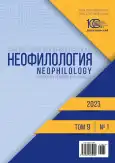Mythopoetics and artistic intertextuality of Tamara Kryukova’s fairy tale “Prisoner of the mirror”
- Authors: Elepova M.Y.1, Kabanova N.G.1
-
Affiliations:
- Northern (Arctic) Federal University named after M.V. Lomonosov
- Issue: Vol 9, No 1 (2023)
- Pages: 143-154
- Section: THEORY OF LITERATURE
- URL: https://journal-vniispk.ru/2587-6953/article/view/295689
- DOI: https://doi.org/10.20310/2587-6953-2023-9-1-143-154
- ID: 295689
Cite item
Full Text
Abstract
T. Kryukova’s fairy tale “Prisoner of the mirror”, the central part of the tetralogy about Queen Zlata and Moon Knight, accumulates various mythological, folklore and literary models. It contains various forms of literary intertextuality, the most important role for understanding the hidden meanings of a fairy tale is played by mythopoetic images and representative allusions. The leitmotif of the looking-glass world, which is the main one for the fairy tale “Prisoner of the mirror”, continues the traditions of ancient mythology, and then Russian and European literature of the 19th–20th centuries, representing the world in a reflected form. The phenomenon of the dialogue of text with other texts, proposed by M.M. Bakhtin, makes it possible to reveal the deep content layers of the work in question. The technique of mythological bricolage, which is manifested in the use of characters and plot moves of ancient Greek mythology, makes it possible to demonstrate, according to Bakhtin, the “holiday of the meaning revival”: the characters of ancient myths Pan, Narcissus symbolize the demonic beginning and the hopelessness of sin, with the exception of the nymph Echo, who appears as the personification of selfless love and acts in an unusual role for her mythological status as a magical assistant to children. In the fairy tale there is also a mixture of heterogeneous characters, some combine the features of an ancient prototype and a character of Russian folklore (Odarka). The traditional characters of Russian folk tales (Bear, Fox, Cat) receive a new status of arbiters of judgment and punishment. Reminiscences from the fairy tales of Ch. Perrault and H.-C. Andersen, L. Carroll and V. Gubarev complicate the artistic drawing of the work. The fate theme, fate, which runs through the work, undergoes a serious transformation in the fairy tale. In ancient fate, as the plot develops, the features of divine providence in the Christian sense become more and more distinct. The position of Varga, who denies personal guilt and responsibility for sin, appears as untenable, the image of the Mirror of Judgment directly refers the reader to the ethical teachings of Christianity. Fairy tale discourse allows the author to declare the Christian paradigm of moral values in a complex interaction of borrowed and original characters, motives, plot moves.
About the authors
M. Yu. Elepova
Northern (Arctic) Federal University named after M.V. Lomonosov
Email: m.elepova@yandex.ru
ORCID iD: 0000-0002-7229-5851
Dr. Sci. (Philology), Professor of Literature Department
17 Severnaya Dvina Emb., Arkhangelsk, 163002, Russian FederationN. G. Kabanova
Northern (Arctic) Federal University named after M.V. Lomonosov
Author for correspondence.
Email: nataliakabanova30@gmail.com
ORCID iD: 0000-0001-8624-3481
Post-Graduate Student, Literature Department
17 Severnaya Dvina Emb., Arkhangelsk, 163002, Russian FederationReferences
- Pavilenis R.I. Ponimanie rechi i filosofiya yazyka [Understanding speech and philosophy of language]. Novoe v zarubezhnoi lingvistike: teoriya rechevykh aktov [New in Foreign Linguistics: Theory of Speech Acts]. Moscow, Progress Publ., 1986, Issue 17, pp. 380-388. (In Russ.) Available at: https://www.booksite.ru/fulltext/novoe_v_zarub/text.pdf
- Lotman Yu.M. Struktura khudozhestvennogo teksta [The Structure of Literary Text]. St. Petersburg, Iskusstvo – SPB Publ., 1998, 285 p. (In Russ.) Available at: https://studylib.ru/doc/651324/lotman-yu.m.--struktura-hudozhestvennogo-teksta
- Denisova T.Yu. Aporia of the fate or were the Greeks fatalists? Idei i ideally = Ideas and Ideals, 2014, vol. 1, no. 3 (21), pp. 57-70. (In Russ.) https://elibrary.ru/sobhfj
- Il’yashenko Ya.Yu. Literary allusions in A.S. Byatt’s fairy tales. Upravlencheskoe kon-sul'tirovanie = Adminis-trative Consulting, 2014, no. 3, pp. 175-180. (In Russ.) https://elibrary.ru/sbpztl
- Kupriyanova E.S. Literaturnye skazki Oskara Uail’da i skazochno-mifologicheskaya poetika romana «Portret Doriana Greya» [The Literary Tales of Oscar Wilde and the Fabulous Mythological Poetics of the Novel the Picture of Dorian Gray]. Veliky Novgorod, Yaroslav-the-Wise Novgorod State University Publ., 2007, 300 p. (In Russ.) https://elibrary.ru/qtalnp
Supplementary files










